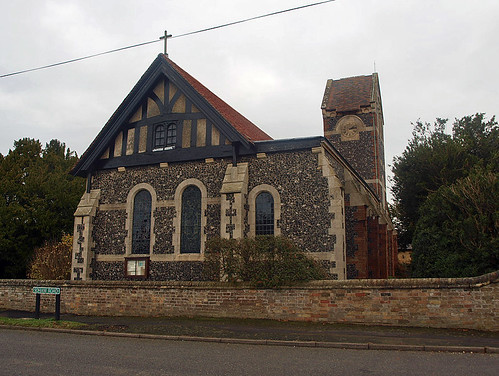HOLY CROSS. From outside the church seems just a particularly unhappy Victorian conceit. Flint, Neo-Norman, with a SE tower with saddleback roof. The trimmings of the flint are red brick. In fact the church is genuinely Norman, though cruelly rebuilt (1876, 1900-2). What survives is only the S doorway with one order of colonnettes and three-dimensional zigzag mouldings, i.e. one on the extrados, and one on the intrados. The former N doorway now appears inside as a recess at the E end of the S aisle. It is of the same time. And the chancel arch is now an opening from the chancel into the organ chamber. This also has one order of columns and the same kind of zigzag arrangement. - FONT. Circular. Called C12 by the VCH. But is it not C18 or at least completely re-tooled in the C18? It has a heavy thick fluting which may be a rustic version of a familiar Wrenian and Georgian motif. C17 Font Cover. - PLATE. Chalice of 1700.
STUNTNEY. It was the first Bishop of Ely who gave it its name. He conceived the idea of making a road across the fens and found a monk named John to plan it.for him. Monk John hit on a steep island rising sharply from the fens and used it as a stepping-stone for his road to Ely, and Stuntney Causeway it has been for eight centuries and more. The old legends tell us that the place for the road was disclosed by St Edmund in a dream, the saint wishing to travel by it to visit St Etheldreda at Ely’s Saxon abbey. So it was that many pilgrims came this way, and as the centuries rolled on there came this way a man of sterner dreams, for the old hall, which is now a gabled house in a cluster of farm buildings, was the home of Cromwell’s mother, and Oliver inherited it from his uncle. Here he spent much time before he became MP for Cambridge, and we think of him looking across the fens to Ely.
The last two generations have turned a fine little Norman church into a plain place with a saddleback tower and a timber arcade. The few remnants of Norman days are in two zigzag doorways, the fine font with a bowl like a water-lily, the walling of the chancel, and the disused chancel arch with its beauty hidden by the organ. There is fine wood carving on the stalls and at the altar, with tiny heads of animals and grotesques.
The last two generations have turned a fine little Norman church into a plain place with a saddleback tower and a timber arcade. The few remnants of Norman days are in two zigzag doorways, the fine font with a bowl like a water-lily, the walling of the chancel, and the disused chancel arch with its beauty hidden by the organ. There is fine wood carving on the stalls and at the altar, with tiny heads of animals and grotesques.

No comments:
Post a Comment